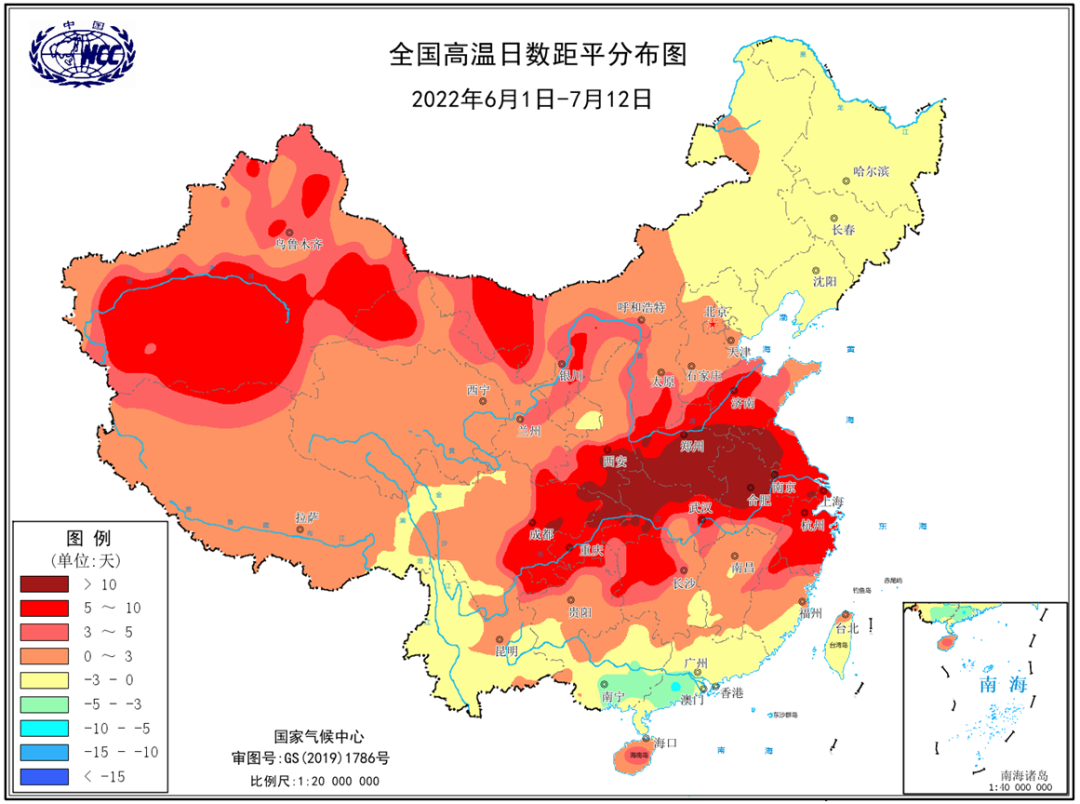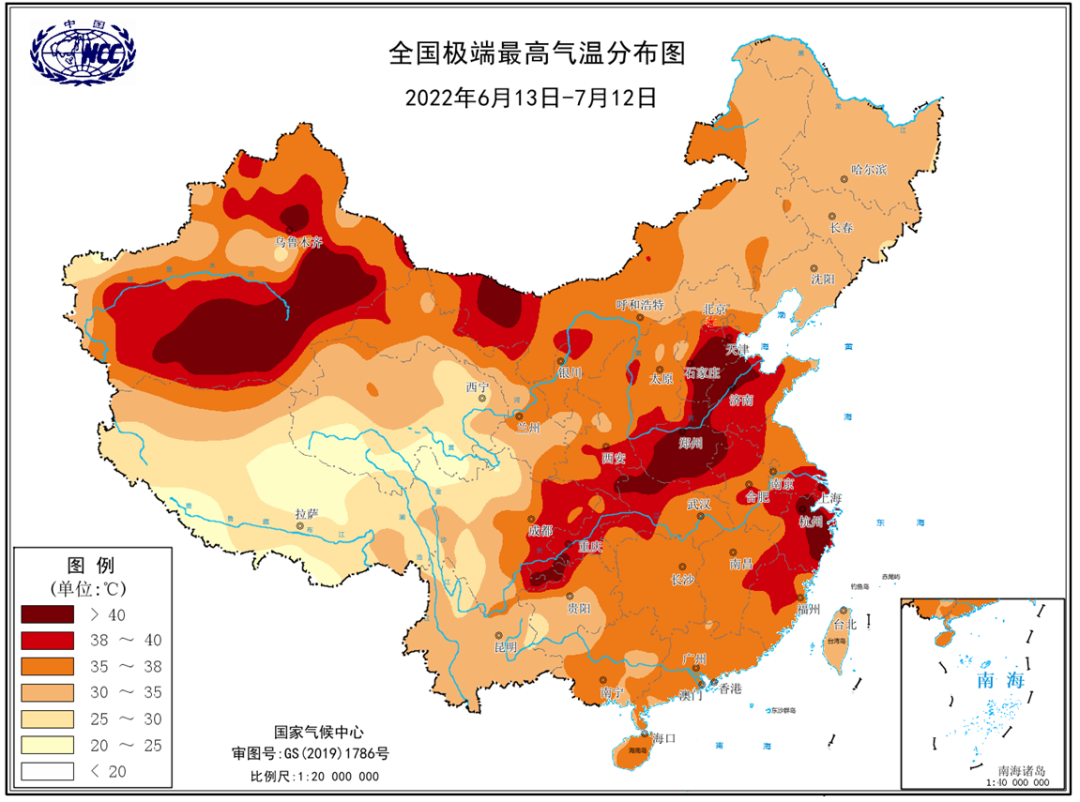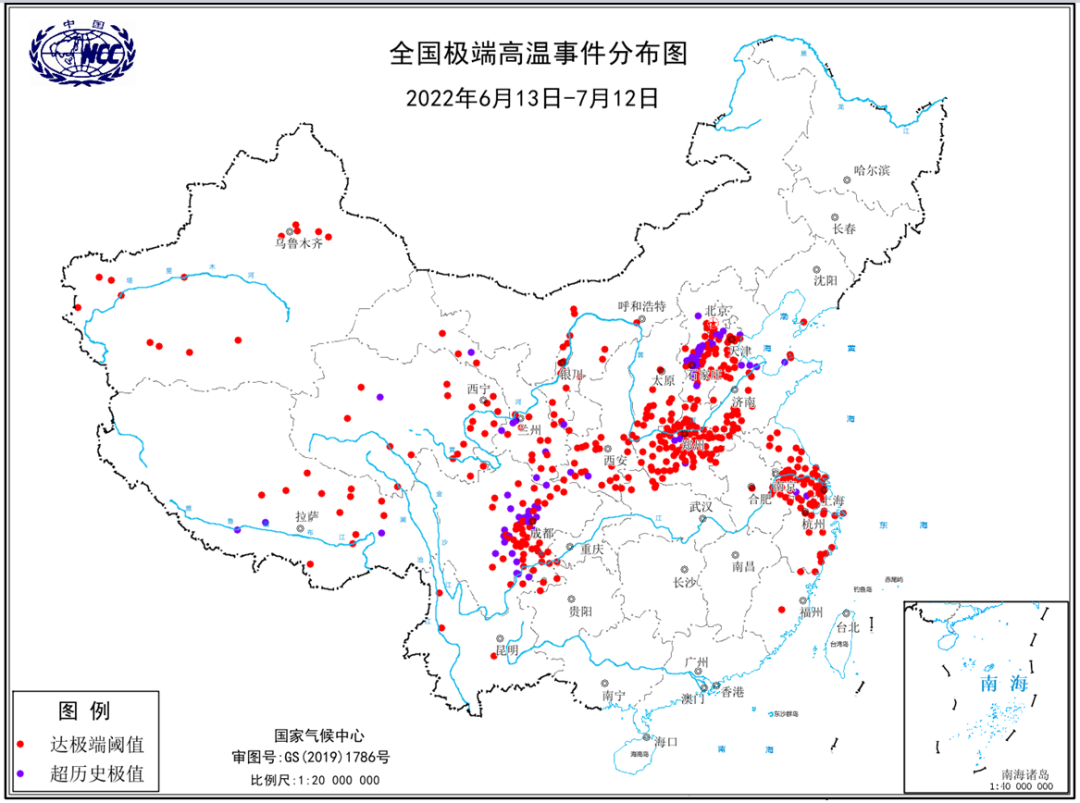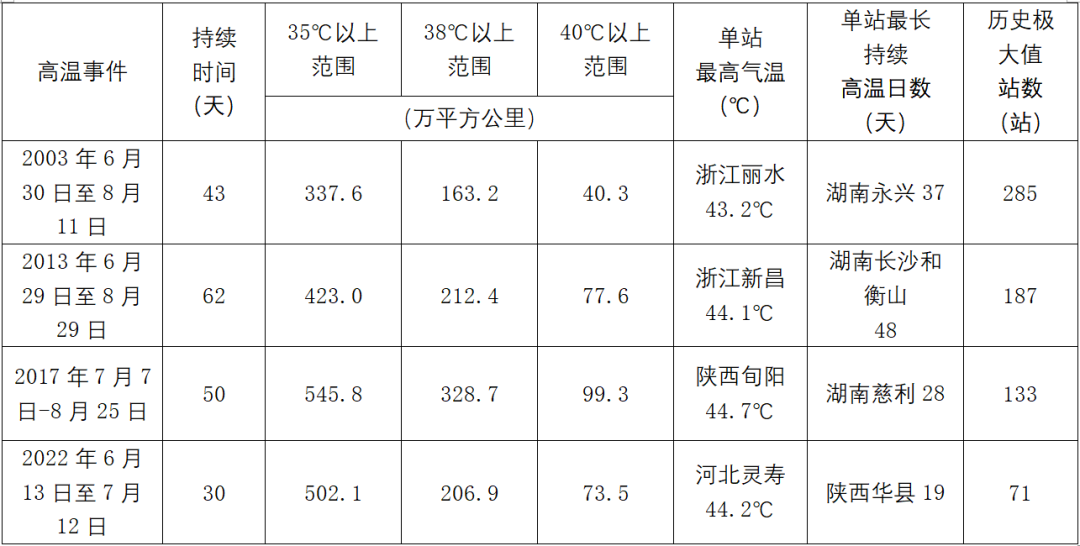Why do we encounter extreme high temperature in my country and the northern hemisphere?| Authoritative interpretation
Author:China Meteorological Administr Time:2022.07.14

In the past few days
my country encounters high temperature weather
High temperature incidents have continued for more than 30 days
It affects the population of more than 900 million people
According to the monitoring of the National Climate Center
June this year
The global average temperature is about 0.4 ℃ higher than usual
The highest since 1979
Northern hemisphere summer high -temperature heat wave incident frequently
So
Recent high temperature extremes in my country and northern hemispheres
What exactly?
What are the reasons for continuous high temperature?
Will the high temperature continue in the future?
The National Climate Center brings an authoritative interpretation
Intersection
my country's high temperature incident has been affecting more than 900 million people for 30 days

On July 10, the temperature in the central urban area of Shanghai once reached 40 ° C.
The monitoring of the National Climate Center shows that since June of this year (as of July 12), the average high temperature number of high temperatures in my country is 5.3 days, which is 2.4 days more than the same period of the year, and it has the most history since 1961. Southern Shaanxi, Henan, southern Hebei, central Shandong and west, Anhui, Jiangsu, Zhejiang, central and northern and northern, Chongqing, central Xinjiang, southern, western Inner Mongolia and other places are 10 to 20 days, of which eastern and southern Henan, south, Anhui, Anhui北部、湖北西北部以及新疆东南部等地超过20天,河南漯河(33天)、永城(31天)、舞钢(31天)、舞阳(31天)、沈丘(31天)、襄The city (30 days) and Shaanxi Huaxian (31 days) and Xinjiang's Lishan (36 days), Lake Lake (33 days) and other high -temperature days of high temperatures exceeded 30 days, and Turpan and Tocoson for Xinjiang for 42 days. Compared with the same period of the same year, the number of high -temperature days in the above areas is generally 5 to 10 days. Among them, most of Henan, northern Hubei, southeast Shaanxi, central Anhui and north, southern Shandong, northwest of Jiangsu have more than 10 days.

From June 1, 2022 to July 12

From June 1st to July 12th, 2022, the national high temperature daily distance distribution (unit: day)
Since June 13, my country has emerged for the first regional high -temperature weather process this year. It has a wide range, long duration, strong extremes, and great impact. As of July 12, the high -temperature incident has lasted 30 days, covering a land area of 50.21 million square kilometers, which has a population of more than 900 million people.

From June 13, 2022 to July 12
The highest temperature of 71 national meteorological stations in the country broke through the historical pole, of which Hebei Lingshou (44.2 ° C), Tancheng (44.1 ° C), Zhengding (44.0 ° C) and Yunnan Yanjin (44.0 ° C) daily reached 44 ° C 44 ° C above.

From June 13, 2022 to July 12th, the distribution of extreme high temperature events in the country
Affected by high temperature weather, since June 13, 7 provincial -level power grids including Hebei, Shandong, Henan, Shaanxi, Gansu, Ningxia, Xinjiang, and Northwest Power Grid have reached a record high. Due to the low temperature and rain, the soil sentimental deviations of the soil in eastern Zhejiang, western Henan, southern Shaanxi, southern Gansu, northern Sichuan, etc., and the drought in some areas continued or developed. Since July, many people in Zhejiang, Jiangsu, Sichuan and other places have been diagnosed with fever, and there have been death cases.
Since entering the 21st century, the typical years of continuous high temperature events in my country are 2003, 2013, 2017, etc. Generally speaking, this year's high temperature incident starts earlier than the above three years, and the number of duration and historical extreme stations is not as good as these 3 years. Although the scope and the highest temperature in the single station are not as good as 2017, it has exceeded 2003 in 2003, but it has exceeded 2003 in 2003, but it has exceeded 2003 in 2003, but it has exceeded 2003. And 2013.
Table in Table 2022 Comparison with typical historical events

High -temperature heat waves in the northern hemisphere tend to be more
According to the monitoring of the National Climate Center, in June of this year, the global average temperature was about 0.4 ° C higher than the usual year, the highest since 1979, of which northern Russia and western Europe were above 2 ° C. The highest temperature in Spain, France, and Italy exceeds 40 ° C, and France, Spain, the United States and Japan and other cities refresh high temperature records. Tokyo, Japan, has five consecutive days of temperature exceeding 35 ° C; high -temperature alerts in central and eastern United States affect the population of about 125 million, surpassing one -third of the American population; and the forest fire caused by extreme high temperatures in Brandonburg, Germany. Compared with the same period of history, the highest temperature in Europe, East Asia, and North America has broken the historical extreme value in the same period in Europe, East Asia, and North America.

In northern Italy, it has encountered severe drought in the near future. Hundreds of towns have stopped water at night, and the longest river water level in Italy has fallen to the lowest level in 70 years. The picture shows the dry river bed map shot in Turin, Italy on June 17/Xinhua News Agency
Since the 21st century, the summer high temperature heat wave event in the northern hemisphere has become more frequent. From June to August 2003, most European areas have experienced rare high -temperature heat wave weather in the past few decades or even hundreds of years. Due to heat.
From June to July 2017, North America, Europe, and Asian countries suffered extremely high temperature weather. The highest temperature in Phoenix City in western United States reached 47 ° C; Portugal, Spain, and Russia's Far East of Russia caused forest fires due to continuous high temperature weather; India and Pakistan also encountered continuous high temperature waves.
On June 10, 2019, a high -temperature heat wave occurred in the western United States. The local temperature of San Diego, California, was as high as 45 ° C, breaking the local high temperature record; there were many forest fires in North California, and about 45 million people in the west of the United States were affected by high temperature heat waves. From July to September 2020, in the southwest of the United States, the hottest and most dry period of the same period since the record, severe fires occurred in California and western Oregon. More than 8,500 buildings were destroyed and 41 people died. The temperature of the valley was as high as 54.4 ° C; on September 6, the temperature of the Woodland Mountains reached 49.4 ° C, which was the highest temperature in the history of Los Angeles.
From June to July 2021, there was a large -scale high -temperature weather in North America. Among them, British British Columbia province refreshed the highest temperature record in the country for three consecutive days, causing more than 700 people to die.
Global warming is the root cause of frequent high -temperature heat wave incidents
The sixth evaluation report of the Special Committee of the United Nations Intergovernmental Climate Change (IPCC) pointed out that global warming in the past 50 years is at an unprecedented speed in the past 2000, and the unstable climate system has intensified. "All -human red alert". Global warming is a frequent climatic background in the high -temperature heat wave event in the northern hemisphere. The abnormal atmospheric circulation is the direct reason for the frequent high -temperature heat waves in the world since June.
Since June this year, over the subtropical regions of the northern hemisphere, the Western Pacific subtropical high -pressure band, the Atlantic high -pressure belt, and the high -pressure average of Iran have enhanced, thereby forming a large -scale global heating high -pressure belt. Under the control of warm and high voltage bands, the prevalence of sinking air is conducive to the heating of the ground. In addition, under the action of a large -scale high -voltage belt, the air is dry and the cloud is not easy to form. , And strong intensity, which causes high temperature heat waves in the northern hemisphere.
Specifically, in my country, the continuous La Nina incident has provided an important climate background condition for the development of high temperature in the south since June of this year. Especially in July, the development of heating and high pressure bands in the middle latitude was strengthened, leading to large -scale high temperature weather. According to statistical analysis, in the summer of most La Nina incidents, the Western Pacific subtropical high -pressure (referred to as auxiliary high) was easy to north. Since late June this year, the deputy high north, especially the typhoon "Siaba" in early July, has strengthened the west extension, Iran's high pressure east, and combined with the high pressure of the mid -latitude continent to form stability over my country. The heating high pressure zone, which causes a large range of high temperature weather. In addition, due to the water vapor carried by the vice -high high, the humidity of the central and eastern regions of my country makes the somatosensory temperature higher.
Future temperature trend outlook
According to the forecast of the Central Meteorological Observatory, in the next 14 days (July 13th to July 26th, 2022), there will be a high temperature weather in Jiangnan South China and other places in my country. From 13th to 16th, there are high temperatures and rainy weather in the Sichuan Basin, Guanzhong, Jianghan, Jianghuai, Jiangnan, Jiangnan, South China and other places. The maximum temperature is generally 35 to 38 ° C and local 39 ° C. From 17th to 20th, the rainfall process will occur in the Sichuan Basin, Jianghan, Jianghuai, Jianghuai, Western Jiangnan and northern parts of the northwestern part of South China. High -temperature weather can be relieved. Southeast Jiangnan and eastern South China will continue to be high -temperature hot weather. After the 21st, the high temperature in the south will develop again, and the scope will expand. The maximum temperature in Fujian, Jiangxi, and southern Zhejiang can reach 39 to 41 ° C.
The National Climate Center predicts that in the next 15 to 30 days (July 27 to August 11, 2022), the temperature in most areas in my country is higher than the same period of the same year. , Southern Shandong, most of Henan, Hubei, northern Hunan, Chongqing, eastern Sichuan, northern Guizhou, Tibet, south of Shaanxi, northern Xinjiang and other places are 1 to 2 ° C. There are many high temperature days in the above -mentioned parts, and there may be a longer -temperature weather process with a longer duration (July 28th to August 2nd, North China, Central China, Central Central China, East of Southwest China, Tibet, and Northern Xinjiang; August 5th to On the 7th, North China, Central East China, Central China Central China, and Northeast China; August 9th to 11th, most of North China and East China), high -temperature heat waves need to prevent the adverse effects of high temperature heat waves on people's production and life and power supply.
Produced by China Meteorological Administration Xuanke Center (China Meteorological News Agency)
Source: National Climate Center (China Meteorological Bureau Climate Change Center)
Edit: Brush
Review: Duan Haoshu

- END -
A full sense of security is full of custom lines to be left to the most beautiful memories of students

I am a freshman of the water academy. This is probably the last time I took a scho...
Zifmou City Yicheng District: Talking about Red Stories Red Gene

He died with his own country and defended the land of the motherland with his life...